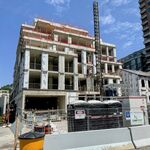kettal
Banned
I really hope and pray that the TTC can get their maintenance money back somehow.
Must? Hardly ... it would be in their interest to stop selling new parts; so as to promote more sales.
Has there been discussion on what TTC will be doing with their CLRV's and ALRV's when the current Bombardier order has been fulfilled?

LRV Fleet Delivery Schedule
- Delivery of 6 Demonstration/Prototype vehicles
By end of 2012- Delivery of 36 production vehicles annually
Starting in 2013- Complete fleet delivery (204 cars)
By end of 2018
Deliveries for the 204-vehicle order are scheduled to take place between 2012 and 2018, with the first prototype vehicles arriving in 2011.
God this is gonna be a long time coming ain't it? Quick, some start a countdown thread! Set time at 3 years....mark!

Streetcar city
That's right, T.O.'s still ...
By MIKE FILEY, SUN MEDIA
It wasn't easy, but after months of meetings documents have been signed that will ensure Toronto retains its title of "streetcar city," a fact that has been part of Toronto's identity since the privately owned Toronto Street Railway Company placed its first horse-drawn public transportation vehicles into service up and down a dusty Church St. on Sept. 11, 1861.
The first few prototypes of Toronto's new generation streetcar, the final assembly of which will take place at the Thunder Bay factory of Bombardier, are scheduled to arrive in town in 2011.
The last of the 204 vehicles should be in service by 2018. In addition, it's likely that several hundred vehicles for the proposed "suburban" Transit City project will be built using many of the features of the "city" streetcar.
Of course, this isn't the first time the TTC has purchased new streetcars.
Soon after its creation by the provincial government in 1920, money came from both the city and province to assist Toronto's new publicly owned transit commission with the purchase a large number of modern new steel streetcars (known as Peter Witts in recognition of the Cleveland transit expert responsible for their modern design).
These cars, each costing $17,000, would quickly replace the uncomfortable, inefficient and, in many cases, unsafe wooden streetcars that had been operated by the TTC's immediate predecessor, the privately owned Toronto Railway Company.
The public's acceptance of the new Toronto Transportation Commission (Transportation became Transit with the opening of the first section of Yonge subway in 1954) was immediate with many thousands riding the much-expanded and improved system every day.
In an effort to stay "ahead of the curve" (not something they'd say back then, but you know what I mean), senior staff of the TTC joined with staff of several other large North American transit companies to help develop a new streetcar, one that would eventually replace the TTC's aging fleet.
The result of this international project was an ultra-modern vehicle to be identified as the "Presidents' Conference Committee Streamliner" or simply the PCC. Initially, interest in purchasing this new streetcar was not overwhelming and it wasn't until the TTC put in its request for 140 of the new cars that the future of the PCC was assured.
Over time, the Commission purchased 540 new and 205 second-hand PCCs for a total of 745, one of the largest PCC fleets in the world. While the last one ran in regular service here in Toronto in December of 1995, two are still made available by the TTC for charters.
An interesting fact concerning the TTC's initial order for 140 new PCC cars is that they cost the Commission $3 million or approximately $21,500 each, with none of that money coming from the city or the province or the federal government (not sure if John Baird was around back then). The total order was paid for out of the TTC's surplus account.
And perhaps even more surprising, the deal was even done without the approval of city council. Such was the status of the TTC in 1938.




